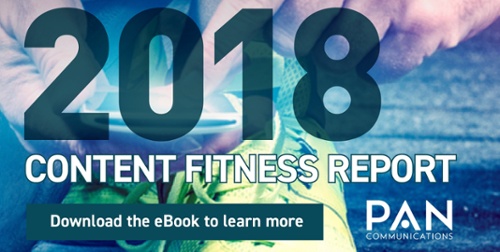This year’s INBOUND 2018 event was my 6th year attending the Boston-based marketing conference. As a marketing manager, I find myself gravitating towards common themes in the tracks I choose, but there’s usually noticeable trending topics that flow through the event as a whole. This year: data – enough said; customer experience + advocacy marketing; and the facts and myths of email marketing.

Read on for some insights from these trends.
Is data the real king of marketing?
Data is a double-edged sword in today’s marketing realm. On the one hand, it fuels campaigns, strategies, budgets, team/department growth and ROI. On the other hand, we have more data than ever to comb through and decipher what is valuable, and what will ultimately help us prove ROI.
Use quantitative data to fuel your marketing strategy’s user experience.
Madison Hajeb, CRO and CX Manager at Clearlink, gave an entertaining and informative session on how to use data to understand and craft user experiences in four steps:
- Understand your goals. Identify which products/services are of the highest value. Where are you making money? Use this data to define your goals and what you want to sell.
- Understand your users. Use tools and techniques such as heatmaps, customer web behavior data and surveys to understand what content your users are interacting with, patterns in behavior and further insights into you user’s needs, interests and experience.
- Model your users. Does your brand have personas? Great – that’s a good starting point. Have you taken it one step further into buyer modalities? Or even further by mapping pattern pathways and identifying your most successful ones? Don’t stop at personification – demographics are important, but behavioral insights provide even more value.
- Craft and test content. Understand the goals of each page in the user flow. Aim to have one CTA per page, and each CTA should take the user to either the conversion point or to the next step in the successful pathway identified. Note changes you make, or implement A/B testing to determine success.
Dive further into defining your integrated marketing and PR strategy here.
Do you struggle from too much data? Fear not; you’re not alone.
I kicked off my first day at INBOUND with a session on how to avoid analysis paralysis – shout out to Amanda Nielsen, a Demand Generation Marketer at New Breed.
Analysis paralysis (adjective) – TFW you have so much data you don’t know what to do with it or where to start. Sound familiar?
In Nielsen’s approach to data analysis, there are three steps to help you organize and prioritize the data that is most insightful to you, your team and your brand:
- Establish Key Performance Indicators (KPIs), Leading Performance Indicators (LPIs), and Tactical Performance Indicators (TPIs). KPIs should relate back to revenue, i.e. SQLS. LPIs consider those middle-of-the-funnel conversions that consistently lead to a KPI conversion. TPIs are micro-conversions like subscribes or social engagements, also known as the plentiful vanity metrics.
- Identify revenue goals to track toward. Let’s talk nerdy for this one:
- Calculate the burdened cost of your marketing team (hint: ask your finance department). Then calculate marketing expense (or your yearly marketing budget). Add the two together to get your breakeven revenue goal.
- Your annual revenue goal divided by your average deal size equals the number of deals your team will need to close in order to see your ROI goal.
- Consider your B2B lifecycle conversion rate benchmarks – or use your own data – to determine your attainment quotas to help you calculate the number of Leads, MQLs, SQLs and Opportunities you’ll need to drive in order to meet your ROI goal.
- Identify funnel gaps. Reference the third bullet above – what are the trends in your historical data telling you? Compare your lifecycle conversion rates to the industry standards – identify where in your process the gaps exist, and then adjust your strategy accordingly.
Data wheels turning?
We want our customers to be champions for our brand… but are we champions for our customers?
Customer marketing, customer loyalty, customer advocacy, customer service, customer experience – the word “customer” was everywhere at INBOUND this year. Whatever you call the stage after a sale (and ICYMI: you should have a stage post-sale), it’s becoming a trend that marketing teams can no longer ignore.
Go beyond personalization with your customers.
Kevin Cochrane, CMO at SAP Customer Experience, talked about how to use data-driven insights to deliver personalized experiences and earn customer loyalty. As part of his presentation, he used a quote: “On a lifetime value basis, emotionally connected customers are more than twice as valuable as highly satisfied customers.”
Key takeaway here: brands don’t want you to just personalize content for them. They don’t want you to just use ‘first name’ and ‘company name’ personalizers in emails. To gain loyal customers, brands need to connect with customers as real people, building a relationship in order to deliver the best customer experience. Trust is a key theme here, and Cochrane states the 3 laws of trusted brands as: Connect; Respect; Protect. On average, it takes 8 seconds to engage, but 1 second to lose trust.
One way to start building trust with your customers is through emotional marketing. Here’s your step-by-step guide.
Get involved in customer service.
Laurie Failoa, HubSpot’s own Director of Customer Marketing, brought up customer service. It’s not separate from the marketing department anymore. There are four steps your marketing team is responsible for – and it goes beyond email and gifts:
- Activation. Enable your customers to get value from the product or service they’ve just purchased by understanding their pain points they’re looking to solve and nailing your onboarding process.
- Revenue. Sell your customers additional value by finding the right moments to introduce new products and services and making it easy to buy more.
- Advocacy. Enable your happiest customers to be your best marketing team. Identify your business needs, ask your happiest customers at the right time to be an advocate and make it worth it.
- Communications. Leverage communication channels to meet your activation, revenue and advocacy goals to ensure that your customers have a great experience.
Customer Success = Product or Service + Marketing + Service + Sales
To sum it up: your brand should be investing in customer marketing, but it should exist throughout your entire organization – it’s not a siloed effort. Your customer’s opinions influence every stage of the buying process. Turn your best customers into advocates to help amplify your brand via referrals and/or social media. Track your progress and improve it over time so you continue to find new ways to delight your customers, both new and old.
Trust is everything.
Every marketer has GDPR on the brain – whether you’re fully compliant, working towards being complaint or choosing to turn a blind eye – it’s officially part of the marketer’s dictionary. But think beyond the legal necessity of GDPR, and think about the customer experience side. There’s a lot of buzz about the amount of data being collected being ‘creepy’ – whether you agree or not, there’s a refreshing perspective behind permission-based marketing.
Consumers care about their privacy. Don’t collect data you don’t need. Protect your customers’, and prospective customers’, data. And ask permission via preference centers, opt-ins, etc. that are consistent with a positive customer experience. Permission builds trust, which ultimately helps lead your brand to ROI.
To stay in-tune to the voice of the customer, follow along with PAN’s EVP of Marketing and Business Development’s blog series: CMO Insights.
In case you were worried, email continues to change, but it’s still not dead.
Carly Brantz, VP of Revenue Marketing at SendGrid, walked through her ‘irresistible email formula’ to inject life into email marketing. If you have questions about subject lines, emojis, A/B testing or benchmarking – find her slides on the INBOUND website.
Formula for Irresistible Emails = Email Elements + Strategy + Creating Relationship with Recipient
Email elements include factors like subject line, copy and images. To summarize: 4-word subject lines have the most engagement; only include emojis when they’re relevant to what you’re saying; one image for every two lines of text; and a REALLY good email actually resonates with your audience.
The right strategy includes creative segmentation that helps you zone in on sending the perfect message. Think purchase history, previous clicks, your email preference center, etc. It also includes testing. All the factors mentioned below – implement A/B testing on these factors and more to find your combination for an irresistible email.
Finally – think about how you would describe your relationship with your recipients. Do they trust you? How will you make a connection? Grow trust by giving before taking; don’t be “click-baity;” and (pleasantly) surprise them by doing something different occasionally.
Of course, while these were the trends and insights I noticed and picked up, there was so much more happening elsewhere throughout the week. What were your takeaways from INBOUND 2018? Tweet us @PANcomm



